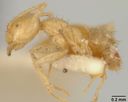Paratrechina
Paratrechina
Classification
- Phylum: Arthropoda
- Subphylum: Hexapoda
- Class: Insecta
- Order: Hymenoptera
- Superfamily: Formicoidea
- Family: Formicidae
- Subfamily: Formicinae
- Tribe: Lasiini
- Genus: Paratrechina
Pronunciation
How to pronounce Paratrechina: //ˌpærəˈtrɛkɪnə//
These audio files are automatically generated. While they are not always 100% accurate, they are a good starting point.
Images






Summary
Paratrechina is a genus of ants within the Formicinae subfamily, primarily known for the longhorn crazy ant, Paratrechina longicornis. The genus has undergone significant taxonomic changes and is recognized for its gracile morphology and global distribution as a pest.
Physical Characteristics
Paratrechina species are recognized by their gracile appearance due to elongate scapes, head, tibiae, and mesosoma. Workers have erect macrosetae on the pronotum and mesonotum but not the propodeum. The mesonotal and metanotal sutures of the mesosoma are always deep and complete, allowing distinct segmentation.
Identification Tips
Distinguishing features include the placement of compound eyes slightly posterior to the midline of the head (except for Paratrechina umbra, which has eyes anteriorly placed) and the number of teeth on the mandible; most have five, exceptions being Paratrechina kohli (eight teeth) and Paratrechina umbra (six teeth).
Habitat
Primarily found in undisturbed habitats, particularly in tropical woodlands; Paratrechina longicornis is specifically noted as a woodland specialist.
Distribution
Most species are native to sub-Saharan Africa and Madagascar. Paratrechina longicornis, an introduced species, is found globally in tropical areas with an unknown native range possibly in Africa or Asia. Paratrechina umbra is native to southern China and Southeast Asia, while Paratrechina zanjensis is found in miombo woodlands across central and eastern Africa.
Diet
Predominantly nectarivorous, these ants may engage in mutualism with caterpillars for sugar and amino acids; additionally, they are opportunistic feeders on various organic materials.
Life Cycle
The reproductive biology includes both sexual reproduction and thelytokous parthenogenesis in which queens can produce female offspring asexually, aiding in genetic recombination without inbreeding.
Reproduction
Research has predominantly focused on Paratrechina longicornis; queens can reproduce both sexually and asexually, and sibling mating is common within colonies.
Ecosystem Role
Paratrechina serves as both a pest and a mutualist, providing protection to caterpillars in exchange for nutrition, and associates with beneficial microorganisms in their environments.
Economic Impact
Paratrechina longicornis is recognized as a widespread pest species, especially in tropical and subtropical regions, impacting local ecosystems and human activities.
Cultural Significance
Featured in popular culture, notably as a companion species in the Marvel movie 'Ant-Man', though depicted behaviors do not perfectly align with real species traits.
Evolution
Paratrechina was found to be paraphyletic with respect to Nylanderia, leading to Nylanderia's elevation to genus level.
Similar Taxa
- Euprenolepis
- Nylanderia
- Paraparatrechina
- Prenolepis
- Pseudolasius
- Zatania
Misconceptions
Commonly confused with Nylanderia species due to similar morphology; also sometimes misidentified as pavement ants, which are a separate species.
Tags
- ontological
- ecology
- pest control
- ant identification
- mutualism